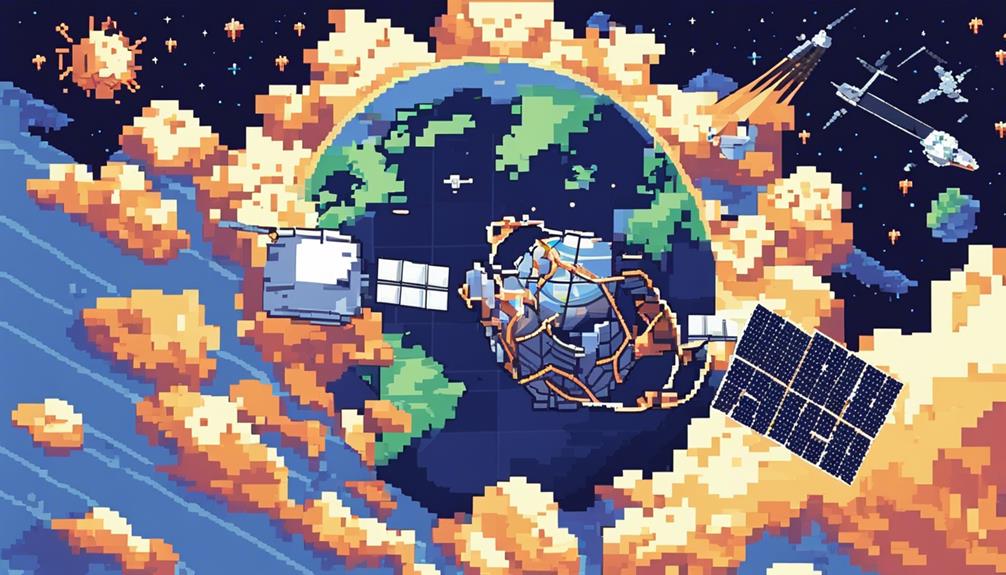Understanding the impact of satellites on the environment is a critical aspect of fostering environmental stewardship in the age of rapid technological advancement. By unraveling the intricate web of interactions between satellite operations and ecological systems, we can grasp the far-reaching implications of our actions beyond the confines of Earth. The intricate dance between technology and nature demands a nuanced approach, prompting us to question the sustainability of satellite use and its repercussions on our planet. In this discourse, we will explore the multifaceted dimensions of satellite technology's environmental footprint, shedding light on the imperative need for informed decision-making and responsible practices in satellite operations.
Key Takeaways
- Public awareness drives responsible space practices and informed decision-making.
- Satellite emissions and space debris pose environmental challenges that require mitigation.
- Educating on eco-friendly satellite design promotes sustainable space operations.
- Advocacy for policy changes and sustainable practices is essential for reducing satellite environmental impact.
Importance of Public Awareness

Public awareness plays a pivotal role in shaping responsible space activities by highlighting the environmental impact of satellites. Educating the public on satellite technology's environmental consequences is essential for fostering informed decision-making regarding space operations. Understanding the effects of satellite activities empowers individuals to advocate for sustainable practices within the space industry. By increasing public awareness, there is a potential for driving policy changes and encouraging industry efforts aimed at minimizing environmental harm caused by satellites.
Furthermore, educating communities on the importance of satellite sustainability can cultivate a sense of collective responsibility for environmental protection. This collective responsibility can lead to a more unified approach towards addressing the environmental challenges posed by satellite technology. By instilling a sense of ownership and accountability among the public, there is a greater likelihood of implementing measures that promote the long-term sustainability of satellite operations.
Environmental Impact of Satellite Technology
The environmental impact of satellite technology encompasses various critical aspects. From the emissions released during rocket launches to concerns about space debris and the energy consumption required to operate satellites, these factors play a significant role in assessing the overall ecological footprint of satellite technology. Understanding the implications of satellite emissions, managing space debris risks, and optimizing energy efficiency are key areas that require attention within the realm of satellite technology's environmental impact.
Satellite Emissions Impact
Rocket launches for satellites, integral to the deployment of satellite technology, significantly contribute to air pollution and emissions of greenhouse gases, thereby impacting the environment. Satellite emissions have various environmental implications, including atmospheric pollution and light pollution. Mitigation strategies are essential to address these challenges and ensure sustainable satellite operations. The table below summarizes key points related to the environmental impact of satellite emissions.
| Aspect | Description | Importance |
|---|---|---|
| Atmospheric Pollution | Rocket launches release pollutants into the atmosphere, contributing to air pollution. | High |
| Light Pollution | Satellite constellations can cause light pollution, disrupting ecosystems and wildlife behavior. | Moderate |
| Mitigation Strategies | Implementing measures to reduce emissions, such as using greener propellants, is crucial. | Critical |
Space Debris Concerns
Concerns surrounding space debris, composed of defunct satellites, rocket stages, and various other fragments, present significant environmental risks and challenges to the sustainability of satellite technology. With over 34,000 objects larger than 10 centimeters currently orbiting Earth, satellite operators face heightened environmental impact and operational risks. Collisions between active satellites and space debris can result in catastrophic consequences, further exacerbating the issue. To address this concern, the development of active debris removal systems utilizing technologies like harpoons and nets is underway. International collaboration is crucial in establishing standardized practices for debris mitigation and removal to ensure the long-term sustainability of space activities. Implementing these measures is imperative to safeguard space infrastructure and prevent the escalation of space debris pollution.
Energy Consumption Analysis
Operating satellite services globally exhibit a substantial energy consumption footprint, significantly impacting the environmental sustainability of satellite technology. The energy consumption of satellite operations varies depending on the sources of energy used, with a shift towards renewable sources such as solar and wind being crucial in reducing the carbon footprint associated with satellite technology. Energy-intensive ground stations also contribute to the overall energy consumption of satellite operations. Implementing sustainable practices within satellite operations, such as optimizing energy use, investing in renewable energy sources, and improving energy efficiency, can help mitigate the environmental impact of energy consumption in the satellite industry. By prioritizing sustainability and embracing eco-friendly solutions, the satellite sector can work towards a more environmentally conscious future.
Sustainable Practices for Satellite Operations
Implementing sustainable practices in satellite operations is crucial for minimizing environmental impact and enhancing long-term operational efficiency. Satellite operators are increasingly turning to solar panels to power satellites, reducing the reliance on non-renewable energy sources. By harnessing energy from the sun, satellites can operate more efficiently and sustainably. Additionally, the integration of efficient propulsion systems in satellites plays a significant role in reducing fuel consumption and minimizing environmental impact during operations. These systems help satellites maneuver in space with greater precision, leading to optimized fuel usage and reduced carbon emissions.
Orbital maneuvering strategies are another key aspect of sustainable satellite operations. By implementing precise orbital maneuvers, satellite operators can extend satellite lifetimes, reducing the need for frequent replacements and lowering overall environmental impact. Furthermore, the use of deployable structures in satellite design enhances mission flexibility and efficiency. Deployable structures allow satellites to adapt to changing mission requirements, optimizing resource utilization and improving overall operational sustainability.
To further enhance sustainability, satellite operators are adopting end-of-life disposal strategies such as controlled deorbiting or boosting satellites to higher orbits. These strategies help minimize space debris generation, ensuring a cleaner orbital environment and promoting long-term sustainability in satellite operations. By prioritizing sustainable practices in satellite operations, the industry can mitigate environmental impact and pave the way for a more efficient and eco-friendly future in space exploration.
Educating on Satellite Debris Management

A critical aspect of space sustainability and operational safety involves educating stakeholders on the effective management of satellite debris. Space debris, comprising defunct satellites, rocket stages, and other remnants, poses significant risks, with over 34,000 objects larger than 10 centimeters creating collision hazards in orbit. Collisions with operational satellites can lead to catastrophic damage, generating more debris and endangering vital satellite services such as communication and navigation. To address this issue, various technologies like harpoons, nets, and active debris removal techniques are being explored to deorbit large objects and reduce collision risks in space.
International collaboration plays a crucial role in space debris management. Forums such as the United Nations Office for Outer Space Affairs (UNOOSA) and the Inter-Agency Space Debris Coordination Committee (IADC) facilitate the sharing of best practices, establishment of standardized regulations, and pooling of resources to tackle the escalating problem of space junk pollution. Moreover, sustainable satellite design, integrating built-in propulsion systems, is essential to prevent debris accumulation and ensure space sustainability for future missions and technological advancements.
| Space Debris Management | International Collaboration | Debris Removal Techniques |
|---|---|---|
| Mitigating collision risks in orbit | Sharing best practices through UNOOSA and IADC | Exploring harpoons and nets for debris removal |
Promoting Sustainable Satellite Design
Sustainable satellite design focuses on efficient power usage, minimizing space debris, and utilizing eco-friendly materials. By optimizing power consumption, satellites can enhance operational efficiency and reduce their overall environmental impact. Incorporating sustainable materials and deorbiting technologies into satellite design plays a crucial role in promoting responsible space practices.
Efficient Power Usage
Efficient power usage is a core focus in the design of sustainable satellites, aiming to minimize environmental impact through the optimization of energy consumption and renewable energy sources. To achieve this goal, satellite designers focus on specific strategies:
- Utilizing Renewable Energy: Solar panels are commonly integrated into satellite designs to harness renewable energy from the sun, reducing the reliance on traditional power sources.
- Energy-Efficient Components: Incorporating energy-efficient components and systems helps decrease overall power consumption in satellites, making them more sustainable and environmentally friendly.
- Advanced Battery Technologies: Optimized battery technologies are crucial for storing and distributing power effectively within satellites, ensuring efficient utilization of energy resources.
Minimize Space Debris
In sustainable satellite design, a critical aspect focuses on minimizing space debris through the incorporation of built-in propulsion systems for controlled deorbiting. These propulsion systems play a vital role in enabling satellites to maneuver to safer orbits or execute controlled re-entry into the Earth's atmosphere at the end of their operational life. By implementing deorbiting technologies, defunct satellites can be prevented from adding to the escalating space debris dilemma. Active debris removal techniques are essential for reducing collision risks in space and ensuring the long-term sustainability of orbital environments. Embracing sustainable design practices in satellite technology is paramount for mitigating the adverse environmental impact associated with space debris, safeguarding both current and future satellite operations.
Eco-Friendly Materials
The integration of environmentally conscious materials is a cornerstone of advancing the sustainability of satellite design. Sustainable satellite design promotes the use of eco-friendly materials such as aluminum and titanium alloys, aiming to reduce the environmental impact of satellite technology. Here are three key points highlighting the importance of eco-friendly materials in satellite design:
- Aluminum and Titanium Alloys: These materials are preferred for satellite construction due to their eco-friendly properties, such as recyclability and lower resource demands.
- Reducing Carbon Footprint: Incorporating sustainable materials in satellite manufacturing helps in decreasing the overall carbon footprint of satellite technology, contributing to environmental preservation.
- Minimizing Negative Environmental Impacts: Eco-friendly satellite design focuses on minimizing the use of scarce elements with adverse environmental effects, promoting a more sustainable approach in the aerospace industry.
Public Engagement in Environmental Conservation
Engaging the public in environmental conservation efforts plays a pivotal role in increasing awareness of the ecological impact of satellite technology. Public engagement serves as a powerful tool to educate individuals about the environmental consequences of satellite operations. By involving communities in discussions about the environmental impact of satellites, it is possible to promote sustainable practices and encourage responsible use of space resources. Through targeted public outreach initiatives focusing on the environmental footprint of satellite technology, individuals can be empowered to advocate for eco-friendly space policies.
Educating the public on the environmental effects of satellites can lead to a better understanding of how these technologies impact ecosystems and wildlife. This awareness can spark conversations on mitigating negative impacts and fostering collaborative solutions to preserve the environment. By encouraging dialogue and providing education on the environmental implications of satellites, a sense of responsibility and stewardship towards the planet's well-being can be cultivated within society. Ultimately, public engagement in environmental conservation related to satellites is crucial for creating a more sustainable and environmentally conscious approach to space exploration and satellite deployment.
Advocating for Satellite Sustainability

Advocating for satellite sustainability entails championing responsible satellite design and operational practices to minimize adverse environmental impacts. To effectively advocate for satellite sustainability, the following key actions can be taken:
- Promoting Responsible Satellite Design: Encouraging the adoption of responsible satellite design principles is crucial in reducing the environmental footprint of satellites. This involves designing satellites with energy-efficient components, utilizing sustainable materials, and incorporating end-of-life disposal strategies to minimize space debris.
- Mitigating Light Pollution: Addressing the issue of light pollution caused by satellites is essential for preserving the natural night sky and reducing the impact on astronomical observations. Advocates can push for the development of satellite technologies that minimize light emissions and explore ways to mitigate the effects of satellite constellations on night-time visibility.
- Fostering International Collaboration: Collaborating on a global scale is key to promoting satellite sustainability. By engaging in international partnerships and advocating for regulatory frameworks, stakeholders can work together to tackle challenges such as space debris management and environmental conservation in space. International collaboration can lead to the establishment of guidelines that promote responsible satellite operations and ensure sustainable practices in the space industry.
Frequently Asked Questions
How Do Satellites Impact the Environment?
Satellites impact the environment through resource depletion, space debris, light pollution, electromagnetic interference, and ozone depletion. For instance, the growing debris population in space, akin to a minefield, poses risks to operational satellites. Additionally, light pollution from satellites disrupts ecosystems and wildlife behavior. These environmental consequences highlight the need for sustainable practices in satellite operations to mitigate their adverse effects on Earth's delicate balance.
How Does Data From Satellites Help Us Understand the Earth's Environment?
Data from satellites plays a crucial role in environmental monitoring through earth observation and remote sensing technologies. Satellite data enables the analysis of environmental trends, aiding in environmental research and conservation efforts. By utilizing satellite applications, scientists can study various aspects of the Earth's environment, such as climate patterns, natural disasters, ocean health, air quality, and pollution levels. This data provides valuable insights into understanding and addressing environmental challenges.
How Do Satellites Help Us Understand Climate Change?
Satellite observations, facilitated by advanced remote sensing technologies, play a pivotal role in understanding climate change. These observations provide critical atmospheric data, aiding in the development of climate models and the monitoring of climate trends. Satellite technology enables comprehensive Earth monitoring, offering valuable insights into environmental changes. Through satellite images, researchers can visually track and analyze the impacts of climate change on our planet, enhancing our understanding of this complex phenomenon.
How Can Acquiring Satellite Imagery Help Us Improve Our Environment?
Acquiring satellite imagery is pivotal for environmental monitoring, aiding resource management, disaster response, urban planning, and biodiversity conservation. Satellite data enables real-time tracking of environmental changes, facilitating informed decision-making in land use, disaster mitigation, and conservation efforts. From assessing deforestation to monitoring pollution levels, satellites play a crucial role in improving environmental sustainability by providing valuable insights for better-informed policies and actions.

